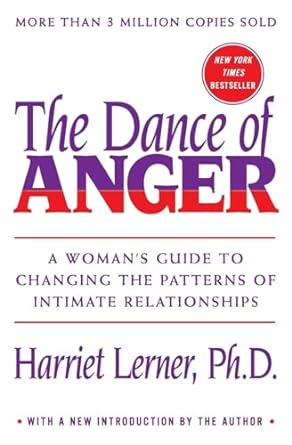The Dance of Anger at Amazon.com
“The Dance of Anger: A Woman’s Guide to Changing the Patterns of Intimate Relationships” by Harriet Lerner is a seminal work that delves into the complexities of anger, particularly in the context of women’s lives and relationships. Lerner, a renowned clinical psychologist, provides a deep understanding of anger’s roots and offers strategies for managing it constructively. The book serves as a guide for women to transform their anger from a source of pain and conflict into a tool for positive change and self-empowerment.
Key themes in the book include:
- Understanding Anger: Lerner explores the nature of anger, emphasizing that it is a natural and necessary emotion that signals something is wrong. She helps readers recognize that anger itself is not destructive, but the ways in which it is often expressed or suppressed can be.
- Patterns of Interaction: The book examines the recurring patterns and dynamics in relationships that lead to anger. Lerner describes how women often fall into roles that suppress their true feelings, leading to frustration and resentment. She provides insights into identifying these patterns and understanding their origins.
- Women’s Unique Challenges: Lerner discusses the specific societal and cultural challenges women face in expressing anger. She addresses how women are often taught to avoid conflict and prioritize harmony, which can lead to internalizing anger or expressing it in passive-aggressive ways.
- The Dance Metaphor: The metaphor of a “dance” is used to illustrate how individuals in relationships engage in predictable patterns of behavior. Lerner explains how changing one’s steps in this dance can lead to significant changes in the relationship dynamic, encouraging healthier and more honest interactions.
- Self-Assertion and Boundaries: A major focus of the book is on self-assertion and setting healthy boundaries. Lerner provides practical advice on how women can express their needs and feelings assertively without escalating conflict, helping them to maintain their integrity and self-respect.
- Tools for Change: The book offers various tools and techniques for managing anger constructively. These include reflective exercises, communication strategies, and methods for staying calm and focused during conflicts. Lerner emphasizes the importance of self-awareness and taking responsibility for one’s own emotions.
- Case Studies and Real-Life Examples: Lerner enriches her narrative with numerous case studies and real-life examples, making the concepts more relatable and providing concrete illustrations of how the strategies can be applied in different situations.
- Empowerment: A central theme of the book is empowerment. Lerner encourages women to see their anger as a catalyst for personal growth and positive change. She advocates for using anger as a tool to uncover deeper truths and to foster more authentic and fulfilling relationships.
Overall, “The Dance of Anger” is a powerful and insightful guide that helps women understand and harness their anger in ways that lead to personal and relational transformation. Harriet Lerner’s compassionate and practical approach makes the book an invaluable resource for women seeking to improve their emotional well-being and the quality of their relationships.
Similar Books
“The Dance of Connection: How to Talk to Someone When You’re Mad, Hurt, Scared, Frustrated, Insulted, Betrayed, or Desperate” by Harriet Lerner
Another insightful book by Harriet Lerner, focusing on improving communication in difficult situations.
“The Dance of Intimacy: A Woman’s Guide to Courageous Acts of Change in Key Relationships” by Harriet Lerner
Explores how women can strengthen their intimate relationships through self-awareness and emotional honesty.
“The Dance of Fear: Rising Above Anxiety, Fear, and Shame to Be Your Best and Bravest Self” by Harriet Lerner
Discusses how to overcome fear and anxiety to live more courageously and authentically.
“Anger: Wisdom for Cooling the Flames” by Thich Nhat Hanh
A guide to understanding and transforming anger through mindfulness and compassion.
“Emotional Intelligence: Why It Can Matter More Than IQ” by Daniel Goleman
Explores the role of emotional intelligence in managing emotions and relationships effectively.
“Radical Acceptance: Embracing Your Life with the Heart of a Buddha” by Tara Brach
Focuses on mindfulness and self-compassion as tools for emotional healing and acceptance.
“Nonviolent Communication: A Language of Life” by Marshall B. Rosenberg
Provides strategies for improving communication and resolving conflicts peacefully.
“Mindfulness for Beginners: Reclaiming the Present Moment—and Your Life” by Jon Kabat-Zinn
An introduction to mindfulness and its benefits for emotional regulation and well-being.
“The Anger Trap: Free Yourself from the Frustrations that Sabotage Your Life” by Les Carter
Offers insights into recognizing and escaping the patterns of anger that can dominate our lives.
“Crucial Conversations: Tools for Talking When Stakes Are High” by Kerry Patterson, Joseph Grenny, Ron McMillan, and Al Switzler
Provides tools for navigating difficult conversations and improving communication in high-stakes situations.
“Boundaries: When to Say Yes, How to Say No to Take Control of Your Life” by Henry Cloud and John Townsend
Discusses the importance of setting healthy boundaries to maintain emotional well-being.
“The Power of Now: A Guide to Spiritual Enlightenment” by Eckhart Tolle
Focuses on the importance of living in the present moment and letting go of past and future worries.
“When Anger Hurts: Quieting the Storm Within” by Matthew McKay, Peter D. Rogers, and Judith McKay
A guide to understanding and managing anger through cognitive-behavioral techniques.
“Letting Go of Anger: The Eleven Most Common Anger Styles and What to Do About Them” by Ronald Potter-Efron and Patricia Potter-Efron
Identifies different anger styles and provides strategies for managing and overcoming each.
“I Thought It Was Just Me (But It Isn’t): Making the Journey from ‘What Will People Think?’ to ‘I Am Enough'” by Brené Brown
Explores the impact of shame and how to develop resilience and self-acceptance.
